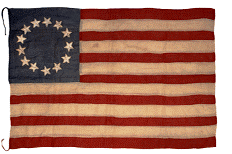
Flag Day, celebrated on June 14, commemorates the adoption of the flag of the United States which occurred on June 14, 1777, by resolution of the Second Continental Congress.
Flag Day is not only to celebrate its creation, but to acknowledge the ideals behind it. It is a time to pay respect to what's become part of American iconography.
▲The Flag adopted by The Flag Resolution
2nd Continental Congress, June 14, 1777
Photo source: http://www.davidcourreges.com/usflag.html
The 1777 resolution, adopted during the American Revolution, states that “the flag of the United States be thirteen alternate stripes red and white” and that “the Union be thirteen stars, white in a blue field, representing a new Constellation.” Our “stars and stripes” was based on the “Grand Union” flag, a banner carried by the Continental Army in 1776 that also consisted of 13 red and white stripes.
AND TO THE REPUBLIC FOR WHICH IT STANDS
Like our country, our flag is a work in progress. Changes have occurred periodically as needed. Each time a state is added to the United States the number of stars is changed to reflect the number of states. The stripes now remain at thirteen representing the original thirteen colonies.

January 13, 1794
“Be it enacted by the Senate and House of Representatives of the United States of America in Congress Assembled, That from and after the first day of May, Anno Domini, one thousand seven hundred and ninety-five, the flag of the United States, be fifteen stripes alternate red and white. That the Union be fifteen stars, white in a blue field.”
▲The Second Flag Act”, 3rd Congress, 1st Session, January 13, 1794
Photo source: http://www.davidcourreges.com/usflag.html
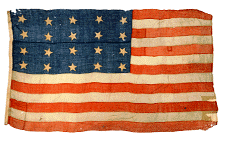
April 4, 1818
"STATUTE I, CHAP. XXXIV - An Act to establish the flag of the United States.
Be it enacted by the Senate and House of Representatives of the United States of America, in Congress assembled, That from and after the fourth day of July next, the flag of the United States be thirteen horizontal stripes,
▲Third Flag Act, 15th Congress, April 4, 1818 alternate red and white: that the union be twenty stars, white in a blue field.
Photo source: http://www.davidcourreges.com/usflag.html
SEC. 2. And be it further enacted, That on the admission of every new state into the Union, one star be added to the union of the flag; and that such addition shall take effect on the fourth day of July then next succeeding such admission.”
You'll notice each time something is changed, the text becomes more long-winded.
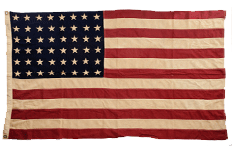
At this point the Executive order becomes very specific about size, height of poles, and a lot of detail that probably went into the Flag Code later on.
◄Executive Order 1556, William Howard Taft, June 24, 1912
Photo source: http://www.davidcourreges.com/usflag.html
ONE NATION, UNDER GOD
Although Flag Day commemorates the adoption of the flag of the United States on June 14, 1777, the “observance” of the flag took about a century. There are a variety of stories and opinions about who started the tradition.
No harm, no foul. Obviously, more than one person can come up with the same or similar idea.
● 1861 - Hartford, Connecticut claims the first celebration.
● 1885 – Grade school teacher Bernard J. Cigrand organized, for his students, the first recognized formal observation of a Flag Day at the Stony Hill School, Waubeka, Wisconsin, to celebrate the flag’s birthday. It was held every year after, and the observance caught on with individual communities and spread rapidly. Apparently, Cigrand had tried for a long time to convince the Congress to declare June 14 as a national holiday.
● 1897 – Governor of New York orders the display of the US flag on all public buildings.
● 1889 - The most recognized claim for initiating Flag Day, according to Wikipedia, came in 1889 from George Bloch, principal of a free kindergarten for the poor of New York City. Bloch had his school hold patriotic ceremonies to observe the anniversary of the Flag Day resolution. This initiative attracted attention from the State Department of Education, which arranged to have the day observed in all public schools thereafter.
Ironically, the man upon whom the honor of being known as the “Father of Flag Day” was bestowed, is William T. Kerr. He is credited for founding The American Flag Day Association in 1888 while he was still a schoolboy in Pittsburgh, Pennsylvania. (I don’t know who gave him recognition as the Father of the American Flag.)
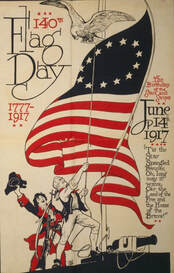
Finally, both President Wilson, in 1916, and President Coolidge, in 1927, issued proclamations asking for June 14 to be observed as the National Flag Day. It wasn’t until August 3, 1949, that a National Flag Day was established by an Act of Congress. However, Flag Day is not an official federal holiday.
◄140th U.S. Flag Day poster.
Artist unknown – US Library of Congress
Photo Source: wikipedia.org/wiki/Flag_Day
INDIVISIBLE, WITH LIBERTY AND JUSTICE FOR ALL
The flag represents the ideals of the United Stated and what it represents, and should be honored and respected as such. How's that working out?
Yes, Virginia, There Really Is A Flag Code
Why are you not surprised? We have laws and codes for just about everything imaginable.
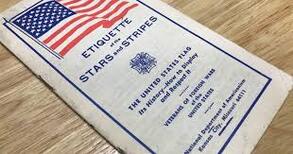
Who knew? But onward! Another reference on the website https://www.legion.org/flag/flagmyths says, "The 77th Congress adopted this codification of rules as public law on June 22, 1942. It is Title 4, United States Code Chapter One."
The Meaning Of The US Flag
While the code does not articulate any definition of what the flag is supposed to mean, it is generally thought of as representing the principles of liberty, justice, and humanity, and the patriotic ideals and spiritual qualities of the citizens of the US.
FLAG MYTHS
Most Americans know a little about the US flag. Some remember that the thirteen stripes in white and red represent the thirteen colonies and the stars on the field of blue represent the union of the states under one federal government. Also, we all have heard, been taught, learned, that Betsy sewed the first US Flag. There are a number of myths, or at least misinterpretations, related to the US Flag.

That’s what I was taught back in the day. In those days, if it was in print, it had to be correct, right? Wrong. There is no historic evidence that Elizabeth Claypoole [her maiden name] Ross was involved in either the design or production of the flag that made its debut in 1777.
It appears that this myth found fertile ground in 1870 when Betsy Ross' grandson, William Canby, first made this claim [100 years later].
▲Metal Print of Illustration of Betsy Ross Sewing The American Flag; Artist unknown. Photo source: fineartamerica.com/george-washington-watching
The Great Seal of the United States of America; Photo Source: https://www.greatseal.com/ ▼

Nothing in the statues mentions an official reason or explanation for the colors of our flag. When people say the colors symbolize something, they are probably referring to the explanation given by Charles Thomson, secretary of the Continental Congress, about the meaning of the colors in the Great Seal of the United States which are also red, white, and blue. Thomson's report to the Congress in 1782, says the "white signifies purity and innocence; red, hardiness and valor; and blue signifies vigilance, preservation, and justice."
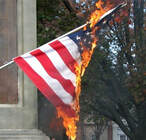
Burning the flag was illegal until 1989, when the Supreme Court ruled 5 to 4 in Texas v. Johnson that burning the flag is a form of symbolic speech protected by the First Amendment. The Supreme Court’s decision invalidated a 1968 national flag-desecration law, as well as similar laws in 48 states (all except Wyoming and Alaska).
In response, Congress passed the Flag Protection Act, but that law was also challenged and wound up in the Supreme Court. The court in 1990 essentially affirmed its earlier ruling, stating that any law banning flag burning violated free speech. Thus, in 2020, burning the flag is still legal, although there are those in Congress currently attempting to change that.
● It's Okay To Wear Clothing Depicting The American Flag
Wait! Don't buy that T-shirt yet. The US Flag Code states the flag "should not" be displayed on any article of merchandise. [Other references say the words are "Shall never".]
Don't worry! The law doesn't have any provisions for enforcement, so are there are no Flag Police lurking around the corner to fine you. However, we should respect the flag, and I don't believe that last photo shows a lot of respect...a lot of everything else, but not respect.
● The Pledge of Allegiance has been recited in Congress and other governmental bodies for a long time
The Pledge was written by Francis Bellamy [a magazine editor] in 1892, and was recited in public schools before 1898. The Pledge wasn't recited on the floor of the House of Representatives until 1988. The Senate began using it as part of the opening ritual in 1999.
● The US Has 51 [or 52?] States
The good old USA has only 50 states. The last one added was Hawaii in 1959. Apparently, some people [mostly outside the US] believe that the federal District of Columbia, Washington DC, is a state, which it is not. Others may include the unincorporated territories like Puerto Rice, Guam, and American Samoa, to name just a few.
The flag code does prohibit the display a US flag with fewer than 50 states. However, any officially approved American flag, irrespective of the number or arrangement of the stars and/or stripes may continue to be used and displayed until no longer serviceable.
MOST IMPORTANT OF ALL
Respect the flag and treat it properly.□
Sources:
http://www.answers.com/Q/What_does_the_United_States_Flag_Represent
http://www.usflag.org
https://www.nyhistory.org/web/crossroads/gallery/all/pewterers_banner.html
https://www.senate.gov/reference/resources/pdf/RL30243.pdf
http://search.excite.com/excite8/search/web?fcoid=417&fcop=topnav&fpid=27&q=flag%20etiquette
https://www.timeanddate.com/holidays/us/flag-day
http://www.debunkingmandelaeffects.com/51-or-52-states-in-the-united-states-of-america/
https://www.legion.org/flag/flagmyths
https://www.reference.com/geography/51-states-fa0d9935e4f12b61
https://www.aflag.com/flag-etiquette/
https://www.va.gov/opa/publications/celebrate/flagdisplay.pdf
http://mentalfloss.com/article/547248/rules-displaying-american-flag
https://www.quora.com/What-does-it-mean-if-the-US-flag-is-upside-down
https://napavalleyregister.com/news/local/use-of-american-flag-as-car-cover-sparks-neighborhood-debate/article_e17bc242-6433-11e1-ad0c-0019bb2963f4.html
https://www.greatseal.com/
https://www.nbc-2.com/story/36587395/condo-resident-being-threatened-with-lawsuit-for-hanging-american-flag
https://www.congress.gov/109/plaws/publ243/PLAW-109publ243.pdf
http://www.revolutionarywararchives.org/betsyross.html
https://fineartamerica.com/featured/vintage-illustration-of-george-washington-watching-betsy-ross-sew-the-american-flag-american-school.html?product=metal-print
2020 Research
https://www.csmonitor.com/USA/2010/0614/Flag-Day-What-are-the-rules-for-displaying-an-American-flag
https://www.va.gov/opa/publications/celebrate/flagday.pdf
https://www.cnn.com/2019/06/14/us/flag-day-2019-trnd/index.html
https://en.wikipedia.org/wiki/Flag_Day_(United_States)
http://www.davidcourreges.com/usflag.html
https://www.sctimes.com/story/opinion/2018/05/19/do-you-know-flag-code/619047002/
conclusion





 RSS Feed
RSS Feed